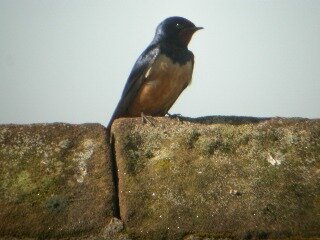Egyptian Swallow
Hirundo rustica savignii Stephens, 1817
Photo © Keith A Naylor
Sub-species
STATUS
Egypt.
OVERVIEW
Sub-species not admitted nationally (BOU 1971).
NOT PROVEN
0). 1853 Cornwall Near Penzance, seen, late summer.
(E. H. Rodd, Zoologist 1853: 3753; Newman, 1866; Harting, 1880).
[BOU, 1883; Penhallurick, 1978].
History E. H. Rodd (1853) in The Zoologist, 1st series, Vol. XI. p. 3753, says: 'A circumstance was mentioned to me yesterday, which may be regarded as interesting and worth a place in the Zoologist, as coming from a naturalist whose general accuracy may be depended upon implicitly. Mr. Vingoe, of this place, whose name has before frequently appeared in your pages, introduced the subject by remarking that he had a strong suspicion that he had discovered, in the later months of the past summer, the Rufous Swallow. His attention was for some time directed to an individual amongst several others, that exhibited an uniform copper colour over the whole of the under parts. At the time he had not seen a figure of the bird in Gould's work, but having occasion afterwards to refer to one of the numbers, he accidentally saw the figure of the Rufous Swallow, and at once recognized it as the new bird he had seen. At a subsequent period I may have to refer to this subject again, and it will then be probably when the bird is captured, and the authority of Mr. Vingoe supported by the fact.'
Admitted nationally (Newman 1866: 331) but not later in their first List of British Birds (BOU 1883: 43).
0). 1866 Cleveland/Co. Durham/Yorkshire Teesmouth, male, shot, 6th July.
(J. H. Gurney, jun., Ibis 8: 423).
History J. H. Gurney, jun. (1866) in The Ibis, Vol. VIII. p. 423, says: 'On the 6th instant I shot at Teesmouth a Swallow of the race to which the names Hirundo riocouri, H. cahirica, H. savignii, and H. boissoneauti seem to have been variously applied. It was a male, and agrees in all respects with specimens in Mr. Tristram's collection, brought from Palestine and marked "Hirundo cahirica", but is not so deeply coloured as the example from Egypt in that gentleman's possession, which was figured by Dr. Bree (Birds of Europe, III. p. 170).'
0). 1943 Cornwall No locality, seen, 2nd May.
(B. H. Ryves, D. Valentine & H. M. Quick, Cornwall Bird-Watching & Preservation Society Report 1943: 37).
History B. H. Ryves, D. Valentine & H. M. Quick (1943) in the Cornwall Bird-Watching & Preservation Society Report, Vol. XXXVII. p. 37, under 'Swallow', say: 'On May 2, I saw a Swallow that looked as red on its underparts as an Egyptian Swallow (T. J. Willcocks of Wadebridge).'
